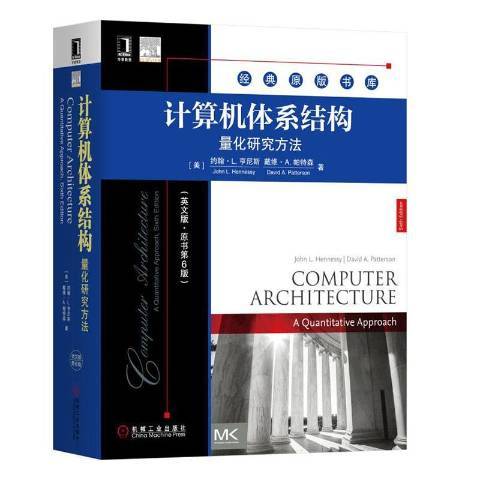《計算機體系結構:量化研究方法》是2019年機械工業出版社出版的圖書,作者是約翰·L.亨尼斯。
基本介紹
- 中文名:計算機體系結構:量化研究方法
- 作者:約翰·L.亨尼斯
- 出版社:機械工業出版社
- 出版時間:2019年7月1日
- 頁數:617 頁
- 開本:16 開
- 裝幀:平裝
- ISBN:9787111631101

《計算機體系結構:量化研究方法》是2019年機械工業出版社出版的圖書,作者是約翰·L.亨尼斯。
《計算機體系結構量化研究方法》(英文版·第4版)系統地介紹了計算機系統的設計基礎、指令集系統結構、流水線和指令集並行技術、層次化存儲系統與存儲設備、互連網路以及多處理器系統等重要內容。1內容簡介在這個最新版中,作者更新了...
《計算機體系結構:量化研究方法(第5版)》是2021年人民郵電出版社出版的圖書,作者是[美]John L.Hennessy、David A.Patterson。內容簡介 《計算機體系結構:量化研究方法(第5版)》是**權 威的計算機體系結構著作,是久負盛名的作品。
《計算機體系結構:量化研究方法》是2007年8月1日電子工業出版社出版的圖書,作者是John L.Hermessy。作者簡介 John L.Hermessy,史丹福大學校長,1977年開始在史丹福大學電子工程系和計算機系任教。他是IEEE和ACM會士,美國國家工程院院士...
《計算機體系結構:量化研究方法》是2019年機械工業出版社出版的圖書,作者是約翰·L.亨尼斯。內容簡介 文藝復興以來,源遠流長的科學精神和逐步形成的學術規範,使西方國家在自然科學的各個領域取得了壟斷性的優勢;也正是這樣的優勢,使...
《計算機體系結構:量化研究方法》是2012年機械工業出版社出版的圖書,作者是亨尼西。本書系統地介紹了計算機系統的設計基礎、存儲器層次結構設計、指令級並行及其開發、數據級並行、GPU體系結構、執行緒級並行和倉庫級計算機等。作者簡介 John ...
《計算機體系結構:量化研究方法(第6版)》是人民郵電出版社出版的圖書,作者約翰• L.亨尼西(John L. Hennessy) , 大衛•A.帕特森(David A. Patterson),譯者賈洪峰。內容簡介 •計算機體系結構領域權威著作,20年來久負盛名...
計算機體系結構是程式設計師所看到的計算機的屬性,即計算機的邏輯結構和功能特徵,包括其各個硬部件和軟部件之間的相互關係。對計算機系統設計者,計算機體系結構是指研究計算機的基本設計思想和由此產生的邏輯結構;對程式設計者是指對系統的功能...
主要研究方向為集群計算機、CPU設計、格線計算、高性能存儲、並行處理與分布計算機系統、面向AI體系結構以及說明性語言的編譯方法和程式開發環境等。近幾年來參加或負責的國家攻關、863計畫和自然科學基金項目10餘項。研究成果達到了國際先進...
《計算機體系結構(第2版)》是作者張晨曦 等 編,2000年高等教育出版社出版的圖書。內容簡介 《計算機體系結構(第2版)》是普通高等教育“十五”國家級規劃教材,第一版被列為“面向21世紀課程教材”,並於2002年獲全國普通高等學校...
1.1 計算機體系結構的概念 1.1.1 存儲程式計算機 1.1.2 計算機體系結構、組成和實現 1.1.3 計算機系統中的層次概念 1.1.4 系列機和兼容 1.2 計算機體系結構的發展 1.2.1 計算機分代、分型與分類 1.2.2 軟體...
《計算機系統結構》是2012年出版的圖書,作者是朱利、李晨。內容簡介 本書從系統設計和套用兩個方面講述現代計算機體系結構的概念、結構、原理和關鍵技術,內容組織上由淺入深、從簡單到高級,涵蓋了該領域的最新進展。全書共12章,分為...
上海市高校教學名師和上海市模範教師。王志英,國防科技大學計算機學院教授、博士生導師,教育部高校計算機類專業教學指導委員會副主任,全國高校計算機教育研究會理事長。研究方向為計算機體系結構、微處理器設計和計算機安全等。
本書統地講述了計算機體系結構的基本概念、基本原理、基本結構和基本分析方法,同時還介紹了ARM公司RISC嵌入式處理器體系結構和Intel公司嵌入式處理器和多核處理器等新內容。內容簡介 《計算機體系結構簡明教程/計算機系列教材·普通高等教育“...
計算機體系結構國家重點實驗室設立五個主要研究方向,即高端計算機體系結構和設計方法、微體系結構、編譯和編程、VLSI與容錯計算、非傳統計算機體系結構。圍繞五個研究方向,結合實驗室現有的基礎和未來的發展規劃,下設五個實驗室(先進計算機...
基於軟體流水方法的新型計算機體系結構的研究 基於軟體流水方法的新型計算機體系結構的研究是由清華大學計算機科學與技術系完成的科技成果,登記於1993年10月31日。成果信息
此外還有一種新興的稱為多執行緒(Multithreading)體系結構將用於超級計算機中,它的代表是Tera公司的MTA系統,一台8 CPU的MTA已經成功地運行在聖地亞哥超級計算機中心。值得注意的是,所有廠家規劃的高檔系統都是機群,已經有廠家開始研究C-...
計算機體系結構與工程 主條目:計算機體系結構和計算機工程 計算機系統結構,或者數字計算機組織,是一個計算機系統的概念設計和根本運作結構。它主要側重於CPU的內部執行和記憶體訪問地址。這個領域經常涉及計算機工程和電子工程學科,選擇和互連...
《計算機系統結構實驗指導》是2019年清華大學出版社出版的一本圖書,作者是秦國鋒、王力生、陸有軍、郭玉臣。內容簡介 本書按照課程培養目標進行CPU的最佳化實驗,在FPGA開發板上對基本硬體電路、CPU各個基礎模組、單周期CPU以及多周期CPU的實現...
由於沒能建立起可量化的安全性指標,故而無法實現性能、效能和安全性的聯合最佳化。因此,發展具有安全性能保證的計算機體系結構已經變得十分緊迫。早在2012年,研究者就提出用創新的變結構軟硬體協同計算架構獲得傳統防禦技術無法比擬的內生...
1.3 電子計算機的分類 15 1.3.1 分類依據與方法 15 1.3.2 微型計算機 16 1.3.3 超級計算機 19 1.3.4 摩爾定律 22 1.4 計算機體系結構 23 1.4.1 馮·諾依曼式計算機 23 1.4.2 哈佛結構 25 1.4.3 非馮·...
1.6 計算機體系結構 15 1.6.1 微型計算機的組成 15 1.6.2 CPU架構 16 1.6.3 計算機匯流排 17 1.6.4 CPU結構 18 思考題 19 第 2章 8086微處理器 21 2.1 8086微處理器結構 21 2.1.1 8086微處理器內部...
米歇爾·杜波依斯(Michel Dubois) 南加州大學電子工程系教授,研究方向為計算機體系結構、並行處理和計算機系統的性能評估。穆拉里·安納瓦拉姆(Murali Annavaram) 南加州大學電子工程系副教授,研究方向為計算機體系結構、3D晶片堆疊和...
